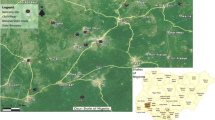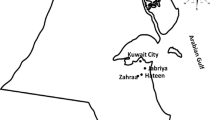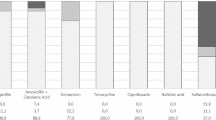Abstract
Aquatic environments are now recognized secondary habitat of potentially pathogenic Escherichia coli. In this study, PCR-based analyses were used to determine the phylogenetic composition and frequency of occurrence of eight clinically significant virulence genes (VGs) in E. coli isolates from sub-tropical Brisbane and cool temperate Tasmania freshwater in Australia. In Brisbane, non-commensal E. coli isolates belonging to the B2 and D phylogenetic group were dominant (72%). A significantly higher number (P < 0.05) of E. coli carrying VGs were detected in the sub-tropical freshwaters compared to the cool temperate water. Furthermore, diarrheagenic pathotype (EHEC) was also observed in the sub-tropical freshwater. The genes east1 and eaeA were significantly more common (P < 0.00001) than other VGs. The eaeA gene which codes for intimin protein along with toxin genes east1, stx 1 , stx 2 , and LT1 were mostly detected in phylogenetic groups B2 and D. The ANOVA results also suggested a statistically significant difference (P < 0.016) between the VGs carried by phylogenetic groups B2 and D. Class 1 integrase (intl1) and class 2 integrase (intl2) genes were detected in 38 (24.83%) and 23 (15.03%) of E. coli isolates, respectively. The Gretna site (Tasmania) with known fecal input from bovine and ovine sources had the highest number of E. coli carrying intl1 (29%) and intl2 (13%) genes. In addition, class 2 integron was more commonly detected in the phylogenetic group B2. The results of this study highlight the need to better understand sources and reasons for the high prevalence of E. coli carrying clinically significant VGs in a sub-tropical environment and its public health implications.




Similar content being viewed by others
References
Anastasi E, Matthews B, Stratton H, Katouli M (2012) Pathogenic Escherichia coli found in sewage treatment plants and environmental waters. Appl Environ Microbiol 78:5536–5541
Barlow M (2009) What antimicrobial resistance has taught us about horizontal gene transfer. Methods Mol Biol 532:397–411
Belanger L, Garenaux A, Harel J, Boulianne M, Nadeau E, Dozois CM (2011) Escherichia coli from animal reservoirs as a potential source of human extraintestinal pathogenic E. coli. FEMS Immunol Med Microbiol 62:1–10
Berthe T, Ratajczak M, Clermont O, Denamur E, Petit F (2013) Evidence for coexistence of distinct Escherichia coli populations in various aquatic environments and their survival in estuary water. Appl Environ Microbiol 79:4684–4693
Bertin Y, Boukhors K, Pradel N, Livrelli V, Martin C (2001) Stx2 subtyping of Shiga toxin-producing Escherichia coli isolated from cattle in France detection of a new Stx2 subtype and correlation with additional virulence factors. J Clin Microbiol 39:3060–3065
Boerlin P, McEwen SA, Boerlin-Petzold F, Wilson JB, Johnson RP, Gyles CL (1999) Associations between virulence factors of Shiga toxin-producing Escherichia coli and disease in humans. J Clin Microbiol 37:497–503
Bonacorsi SPP, Clermont O, Tinsley C, Le Gall I, Beaudoin J-C, Elion J, Nassif X, Bingen E (2000) Identification of regions of the Escherichia coli chromosome specific for neonatal meningitis-associated strains. Infect Immun 68:2096–2101
Bridge JW, Oliver DM, Chadwick D, Godfray HCJ, Heathwaite AL, Kay D, Maheswaran R, McGonigle DF, Nichols G, Pickup R (2010) Engaging with the water sector for public health benefits waterborne pathogens and diseases in developed countries. Bull World Health Organ 88:873–875
Caprioli A, Morabito S, Brugere H, Oswald E (2005) Enterohaemorrhagic Escherichia coli emerging issues on virulence and modes of transmission. Vet Res 36:289–311
Chandran A, Mazumder A (2015) Pathogenic potential, genetic diversity, and population structure of Escherichia coli strains isolated from a forest-dominated watershed (Comox Lake) in British Columbia, Canada. Appl Environ Microbiol 81:1788–1798
Chen B, Zheng W, Yu Y, Huang W, Zheng S, Zhang Y, Guan X, Zhuang Y, Chen N, Topp E (2011) Class 1 integrons, selected virulence genes, and antibiotic resistance in Escherichia coli isolates from the Minjiang River, Fujian Province, China. Appl Environ Microbiol 77:148–155
Clermont O, Bonacorsi S, Bingen E (2000) Rapid and simple determination of the Escherichia coli phylogenetic group. Appl Environ Microbiol 66:4555–4558
Clermont O, Christenson JK, Denamur E, Gordon DM (2013) The Clermont Escherichia coli phylo-typing method revisited improvement of specificity and detection of new phylo-groups. Environ Microbiol Rep 5:58–65
Croxen MA, Finlay BB (2010) Molecular mechanisms of Escherichia coli pathogenicity. Nat Rev Microbiol 8:26–38
Deng Y, Bao X, Ji L, Chen L, Liu J, Miao J, Chen D, Bian H, Li Y, Yu G (2015) Resistance integrons: class 1, 2 and 3 integrons. Ann Clin Microbiol Antimicrob 14:45
DeVinney R, Gauthier A, Abe A, Finlay BB (1999) Enteropathogenic Escherichia coli a pathogen that inserts its own receptor into host cells. Cell Mol Life Sci 55:961–976
Duriez P, Clermont O, Bonacorsi S, Bingen E, Chaventre A, Elion J, Picard B, Denamur E (2001) Commensal Escherichia coli isolates are phylogenetically distributed among geographically distinct human populations. Microbiology 147:1671–1676
Duris JW, Haack SK, Fogarty LR (2009) Gene and antigen markers of shiga-toxin producing E. coli from Michigan and Indiana river water occurrence and relation to recreational water quality criteria. J Environ Qual 38:1878–1886
Edge TA, Hill S (2005) Occurrence of antibiotic resistance in Escherichia coli from surface waters and fecal pollution sources near Hamilton, Ontario. Can J Microbiol 51:501–505
Figueira V, Serra E, Manaia CM (2011) Differential patterns of antimicrobial resistance in population subsets of Escherichia coli isolated from waste- and surface waters. Sci Total Environ 409:1017–1023
Fluit AC, Schmitz FJ (2004) Resistance integrons and super-integrons. Clin Microbiol Infect 10:272–288
Frost LS, Leplae R, Summers AO, Toussaint A (2005) Mobile genetic elements the agents of open source evolution. Nat Rev Microbiol 3:722–732
Gillings MR, Gaze WH, Pruden A, Smalla K, Tiedje JM, Zhu Y-G (2014) Using the class 1 integron-integrase gene as a proxy for anthropogenic pollution. ISME J 9:1269–1279
Gordon DM, Cowling A (2003) The distribution and genetic structure of Escherichia coli in Australian vertebrates host and geographic effects. Microbiology 149:3575–3586
Guion CE, Ochoa TJ, Walker CM, Barletta F, Cleary TG (2008) Detection of diarrheagenic Escherichia coli by use of melting-curve analysis and real-time multiplex PCR. J Clin Microbiol 46:1752–1757
Hall RM, Collis CM (2006) Mobile gene cassettes and integrons capture and spread of genes by site-specific recombination. Mol Microbiol 15:593–600
Hamelin K, Bruant G, El-Shaarawi A, Hill S, Edge TA, Bekal S, Fairbrother JM, Harel J, Maynard C, Masson L, Brousseau R (2006) A virulence and antimicrobial resistance DNA microarray detects a high frequency of virulence genes in Escherichia coli isolates from Great Lakes recreational waters. Appl Environ Microbiol 72:4200–4206
Hamelin K, Bruant G, El-Shaarawi A, Hill S, Edge TA, Fairbrother J, Harel J, Maynard C, Masson L, Brousseau R (2007) Occurrence of virulence and antimicrobial resistance genes in Escherichia coli isolates from different aquatic ecosystems within the St. Clair River and Detroit River areas. Appl Environ Microbiol 73:477–484
Higgins JA, Belt KT, Karns JS, Russell-Anelli J, Shelton DR (2005) tir- and stx-positive Escherichia coli in stream waters in a metropolitan area. Appl Environ Microbiol 71:2511–2519
Hoffmann H, Hornef MW, Schubert S, Roggenkamp A (2001) Distribution of the outer membrane haem receptor protein ChuA in environmental and human isolates of Escherichia coli. Int J Med Microbiol 291:227–230
Ibekwe AM, Murinda SE, Graves AK (2011) Genetic diversity and antimicrobial resistance of Escherichia coli from human and animal sources uncovers multiple resistances from human sources. PLoS One 6:e20819
Itoh Y, Nagano I, Kunishima M, Ezaki T (1997) Laboratory investigation of enteroaggregative Escherichia coli O untypeable H10 associated with a massive outbreak of gastrointestinal illness. J Clin Microbiol 35:2546–2550
Jimenez L, Muniz I, Toranzos GA, Hazen TC (1989) Survival and activity of Salmonella typhimurium and Escherichia coli in tropical freshwater. J Appl Bacteriol 67:61–69
Johnson JR, O'Bryan TT, Kuskowski M, Maslow JN (2001) Ongoing horizontal and vertical transmission of virulence genes and papA alleles among Escherichia coli blood isolates from patients with diverse-source bacteremia. Infect Immun 69:5363–5374
Johnson JR, Oswald E, O'Bryan TT, Kuskowski MA, Spanjaard L (2002) Phylogenetic distribution of virulence-associated genes among Escherichia coli isolates associated with neonatal bacterial meningitis in the Netherlands. J Infect Dis 185:774–784
Kaper JB, Nataro JP, Mobley HL (2004) Pathogenic Escherichia coli. Nat Rev Microbiol 2:123–140
Kerrn MB, Klemmensen T, Frimodt-Moller N, Espersen F (2002) Susceptibility of Danish Escherichia coli strains isolated from urinary tract infections and bacteraemia, and distribution of sul genes conferring sulphonamide resistance. J Antimicrob Chemother 50:513–516
Khan A, Das SC, Ramamurthy T, Sikdar A, Khanam J, Yamasaki S, Takeda Y, Nair GB (2002) Antibiotic resistance, virulence gene, and molecular profiles of Shiga toxin-producing Escherichia coli isolates from diverse sources in Calcutta, India. J Clin Microbiol 40:2009–2015
Koczura R, Mokracka J, Barczak A, Krysiak N, Kaznowski A (2013) Association between the presence of class 1 integrons, virulence genes, and phylogenetic groups of Escherichia coli isolates from river water. Microb Ecol 65:84–90
Koczura R, Krysiak N, Taraszewska A, Mokracka J (2015) Coliform bacteria isolated from recreational lakes carry class 1 and class 2 integrons and virulence-associated genes. J Appl Microbiol 119:594–603
Lecointre G, Rachdi L, Darlu P, Denamur E (1998) Escherichia coli molecular phylogeny using the incongruence length difference test. Mol Biol Evol 15:1685–1695
López-Saucedo C, Cerna JF, Villegas-Sepulveda N, Thompson R, Velazquez FR, Torres J, Tarr PI, Estrada-García T (2003) Single multiplex polymerase chain reaction to detect diverse loci associated with diarrheagenic Escherichia coli. Emerg Infect Dis 9:127–131
Masters N, Wiegand A, Ahmed W, Katouli M (2011) Escherichia coli virulence genes profile of surface waters as an indicator of water quality. Water Res 45:6321–6333
Ménard L-P, Dubreuil JD (2002) Enteroaggregative Escherichia coli heat-stable enterotoxin 1 (EAST1) a new toxin with an old twist. Crit Rev Microbiol 28:43–60
Nataro JP, Kaper JB (1998) Diarrheagenic Escherichia coli. Clin Microbiol Rev 11:142–201
Ochman H, Lawrence JG, Groisman EA (2000) Lateral gene transfer and the nature of bacterial innovation. Nature 405:299–304
Olsen SJ, Miller G, Breuer T, Kennedy M, Higgins C, Walford J, McKee G, Fox K, Bibb W, Mead P (2002) A waterborne outbreak of Escherichia coli O157:H7 infections and hemolytic uremic syndrome implications for rural water systems. Emerg Infect Dis 8:370–375
Orman BE, Pineiro SA, Arduino S, Galas M, Melano R, Caffer MI, Sordelli DO, Centron D (2002) Evolution of multiresistance in nontyphoid Salmonella serovars from 1984 to 1998 in Argentina. Antimicrob Agents Chemother 46:3963–3970
Partridge SR, Tsafnat G, Coiera E, Iredell JR (2009) Gene cassettes and cassette arrays in mobile resistance integrons. FEMS Microbiol Rev 33:757–784
Parveen S, Murphree RL, Edmiston L, Kaspar CW, Portier KM, Tamplin ML (1997) Association of multiple-antibiotic-resistance profiles with point and nonpoint sources of Escherichia coli in Apalachicola Bay. Appl Environ Microbiol 63:2607–2612
Perini L, Quero GM, Garcia ES, Luna GM (2015) Distribution of Escherichia coli in a coastal lagoon (Venice, Italy): temporal patterns, genetic diversity and the role of tidal forcing. Water Res 87:155–165
Picard B, Garcia JS, Gouriou S, Duriez P, Brahimi N, Bingen E, Elion J, Denamur E (1999) The link between phylogeny and virulence in Escherichia coli extraintestinal infection. Infect Immun 67:546–553
Qadri F, Svennerholm AM, Faruque AS, Sack RB (2005) Enterotoxigenic Escherichia coli in developing countries epidemiology, microbiology, clinical features, treatment, and prevention. Clin Microbiol Rev 18:465–483
Rao MR, Abu-Elyazeed R, Savarino SJ, Naficy AB, Wierzba TF, Abdel-Messih I, Shaheen H, Frenck RW, Svennerholm A-M, Clemens JD (2003) High disease burden of diarrhea due to enterotoxigenic Escherichia coli among rural Egyptian infants and young children. J Clin Microbiol 41:4862–4864
Shelton DR, Karns JS, Higgins JA, Van Kessel JA, Perdue ML, Belt KT, Russell-Anelli J, Debroy C (2006) Impact of microbial diversity on rapid detection of enterohemorrhagic Escherichia coli in surface waters. FEMS Microbiol Lett 261:95–101
Sidhu JP, Ahmed W, Hodgers L, Toze S (2013) Occurrence of virulence genes associated with diarrheagenic pathotypes in Escherichia coli isolates from surface water. Appl Environ Microbiol 79:328–335
Sidhu JP, Skelly E, Hodgers L, Ahmed W, Li Y, Toze S (2014) Prevalence of enterococcus species and their virulence genes in fresh water prior to and after storm events. Environ Sci Technol 48:2979–2988
Stange C, Sidhu JP, Tiehm A, Toze S (2016) Antibiotic resistance and virulence genes in coliform water isolates. Int J Hyg Environ Health 219:823–831
Steinsland H, Valentiner-Branth P, Perch M, Dias F, Fischer TK, Aaby P, Mølbak K, Sommerfelt H (2002) Enterotoxigenic Escherichia coli infections and diarrhea in a cohort of young children in Guinea-Bissau. J Infect Dis 186:1740–1747
Tenaillon O, Skurnik D, Picard B, Denamur E (2010) The population genetics of commensal Escherichia coli. Nat Rev Microbiol 8:207–217
Toma C, Lu Y, Higa N, Nakasone N, Chinen I, Baschkier A, Rivas M, Iwanaga M (2003) Multiplex PCR assay for identification of human diarrheagenic Escherichia coli. J Clin Microbiol 41:2669–2671
Turner SM, Scott-Tucker A, Cooper LM, Henderson IR (2006) Weapons of mass destruction virulence factors of the global killer enterotoxigenic Escherichia coli. FEMS Microbiol Lett 263:10–20
Vidal R, Vidal M, Lagos R, Levine M, Prado V (2004) Multiplex PCR for diagnosis of enteric infections associated with diarrheagenic Escherichia coli. J Clin Microbiol 42:1787–1789
Viljanen MK, Peltola T, Junnila SY, Olkkonen L, Jarvinen H, Juistila M, Huovinen P (1990) Outbreak of diarrhoea due to Escherichia coli O111:B4 in schoolchildren and adults association of Vi antigen-like-reactivity. Lancet 336:831–834
Wang G, Clark CG, Rodgers FG (2002) Detection in Escherichia coli of the genes encoding the major virulence factors, the genes defining the O157 H7 serotype, and components of the type 2 Shiga toxin family by multiplex PCR. J Clin Microbiol 40:3613–3619
Winfield MD, Groisman EA (2003) Role of nonhost environments in the lifestyles of Salmonella and Escherichia coli. Appl Environ Microbiol 69:3687–3694
Yamamoto T, Nakazawa M (1997) Detection and sequences of the enteroaggregative Escherichia coli heat-stable enterotoxin 1 gene in enterotoxigenic E. coli strains isolated from piglets and calves with diarrhea. J Clin Microbiol 35:223–227
Yue WF, Du M, Zhu MJ (2012) High temperature in combination with UV irradiation enhances horizontal transfer of stx2 gene from E. coli O157H7 to non-pathogenic E. coli. PLoS One 7:e31308
Acknowledgements
This research was undertaken and funded as part of the Urban Water Security Research Alliance, a scientific collaboration in South East Queensland, Australia, between the Queensland Government, CSIRO Water for a Healthy Country Flagship Program, The University of Queensland, and Griffith University. The authors also wish to acknowledge the support of TasWater staff in the collection of water samples from Tasmania.
Author information
Authors and Affiliations
Corresponding author
Additional information
Responsible editor: Diane Purchase
Electronic supplementary material
Table S1
(DOCX 27 kb)
Rights and permissions
About this article
Cite this article
Sidhu, J.P.S., Jagals, P., Smith, A. et al. Comparative prevalence of Escherichia coli carrying virulence genes and class 1 and 2 integrons in sub-tropical and cool temperate freshwater. Environ Sci Pollut Res 24, 18263–18272 (2017). https://doi.org/10.1007/s11356-017-9497-0
Received:
Accepted:
Published:
Issue Date:
DOI: https://doi.org/10.1007/s11356-017-9497-0




